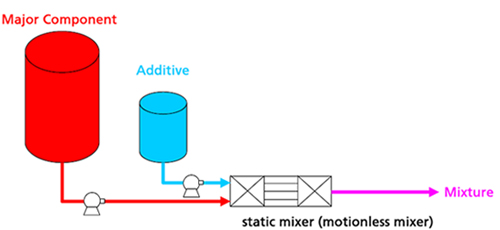
| Principles of Operation of Static Mixers For more than 40 years, static mixers (also known as motionless mixers) have been successfully used as inline mixers for the mixing/dispersing, reaction and heating/cooling of high and low viscosity liquids, slurries, gases and the multi-phase contacting of gases, solids and liquids. Motionless mixers are capable of mixing materials with equal or very different viscosities and volumetric flow rates. The static mixer design best suited for a specific application is based on the process unit operation being practiced. As shown in Figure #1, static mixers are used in continuous processes where they homogenize fluids with no moving parts. Pumps or blowers are used to deliver the components to be mixed at the desired volumetric flow rates and to also supply the pressure energy required for mixing. Typical sizes of static mixers range from very small laboratory size units that fit into 3/16” diameter tubing, process piping that ranges from 1/4” Sch. 40 to over 120”-diameter and square/rectangular ducting such as 46-feet by 13-feet for power plant flue gas treatment. |

Figure #1: In continuous processes, inline static mixers create a homogeneous mix in a short length with no moving parts.
|
As shown in Figure #2, a static mixer consists of individual mixing elements stacked in series. Each mixing element is oriented 90o relative to the adjacent mixing element to create homogeneous mixing in both the horizontal and vertical directions. The static mixing elements divide and recombine the feed materials so that the stream exiting the static mixer is homogeneous with regard to concentration, temperature and velocity which are equalized throughout the entire pipe cross-section.
 Figure #2: Homogeneity achieved with GX static mixing elements |
The number of mixing elements required for a specific application is a function of the customer's process and system requirements with consideration for the degree of mixing required, pressure drop limitations and fluid properties such as flow rate, viscosity, density, etc.
As with most process equipment, there are sometimes dramatic differences in performance between various designs. This statement also holds true for static mixers. For example, Figure #3 shows the homogeneity achieved with the HT helical static mixer which when compared to the performance of the GX static mixer (Figure #2), a dramatic difference in mixing quality is seen. Although the HT static mixer performance (Figure #3) is dramatically lower than the GX static mixer (Figure #2), the HT static mixer is still used extensively because of its lower pressure drop and open non-fouling design.
 Figure #3: Homogeneity achieved with HT helical static mixer
|
More Information
Technical Bulletin (pdf 708 kb)
Movie (wmv 1.14 MB)
Customer Technical Specification Questionnaire (Excel 133 kb)
Home | Principles of Operation | Products | Applications & Industries | Technical Information | About Us | Contact Us
Request A Quote | Mixer Selection Guide | Site Map
Mexico & South America: StaMixCo-Mexico; Geranios 26, J del Alba; C. Izcalli; 54750 Estado de Mexico; Tel: 52 (55) 2876 2311
USA & Canada: StaMixCo LLC; 235-84th Street; Brooklyn, New York 11209 U.S.A.: Tel: (718) 748-4600
Europe, Asia-Pacific, Africa: StaMixCo Technology Ltd.; Ebnetstrasse 8; CH-8474 Dinhard, Switzerland: Tel: +41 52 338 17 11
© 2008 StaMixCo, LLC. | Powered by Register.com
Request A Quote | Mixer Selection Guide | Site Map
Mexico & South America: StaMixCo-Mexico; Geranios 26, J del Alba; C. Izcalli; 54750 Estado de Mexico; Tel: 52 (55) 2876 2311
USA & Canada: StaMixCo LLC; 235-84th Street; Brooklyn, New York 11209 U.S.A.: Tel: (718) 748-4600
Europe, Asia-Pacific, Africa: StaMixCo Technology Ltd.; Ebnetstrasse 8; CH-8474 Dinhard, Switzerland: Tel: +41 52 338 17 11
© 2008 StaMixCo, LLC. | Powered by Register.com